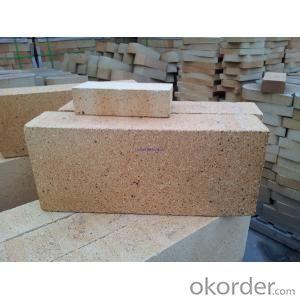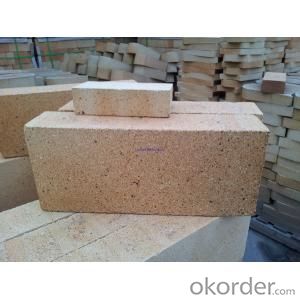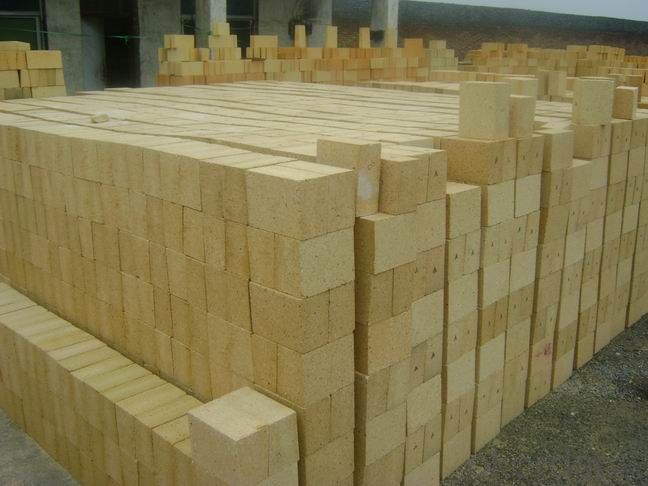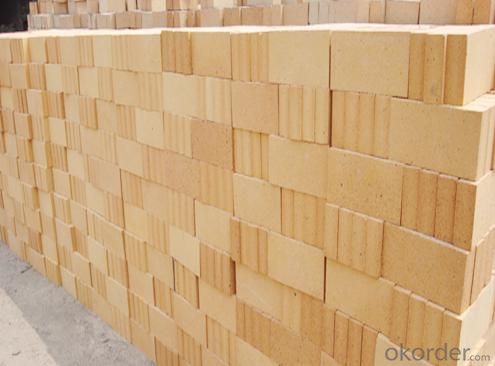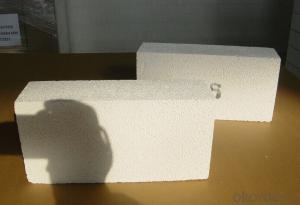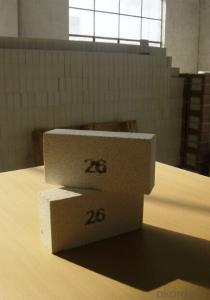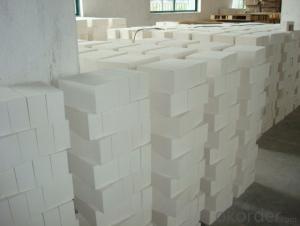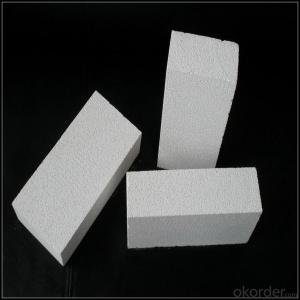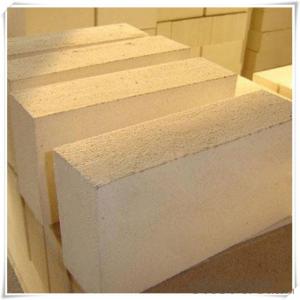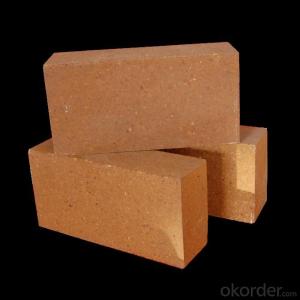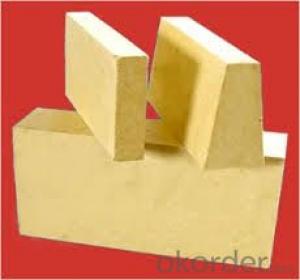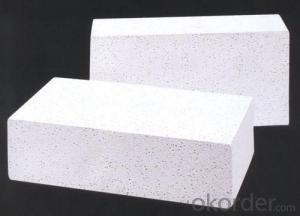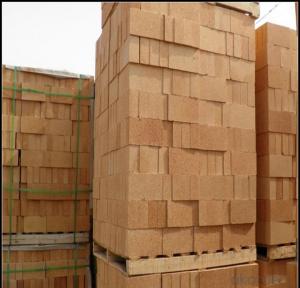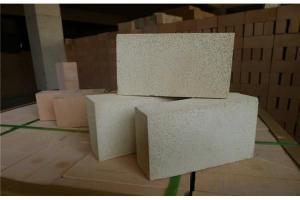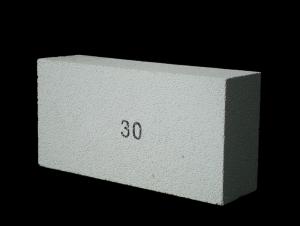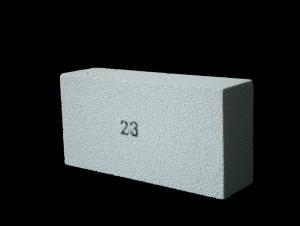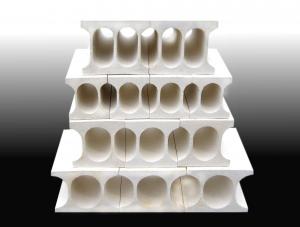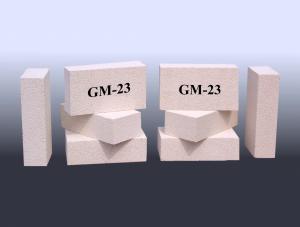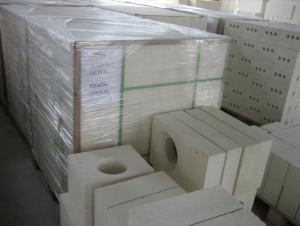Insulating Fire Brick for Thermal Insulation in Steel Industry
- Loading Port:
- Tianjin
- Payment Terms:
- TT OR LC
- Min Order Qty:
- 20 m.t.
- Supply Capability:
- 10000 m.t./month
OKorder Service Pledge
OKorder Financial Service
You Might Also Like
CNBM conforms strictly to the requirements of ISO 9000 quality control system during the production. MSDS is also available if you want. The thermal insulation fire clay brick meet with the requirements of ASTM & JIS standards. So pls stay cool with our quality.
Insulating Fire Brick Technical index
Product No. | IFB70 | IFB60 | IFB50 | IFB40 |
Al2O3 | 68%-72% | 58%-62% | 48%-52% | 38%-40% |
Refractoriness (°C ) | ≥1790 | ≥1790 | ≥1790 | ≥1790 |
Bulk density (g/cm3) | 2.50-2.60 | 2.35-2.45 | 2.20-2.30 | 2.10-2.20 |
Apparent porosity (%) | 22 | 19-22 | 17-20 | 17-20 |
Cold Crushing strength (kg) | 480-510 | 450-480 | 430-450 | 390-430 |
Application
Insulating Fire Brick are used for the lining of converter, alternating current arc furnace, direct Current arc furnace and the ladle slag line, etc.
Equipment
1 unit of Ceramic Abrasive (SG Abrasive) pilot production line
2 units of Compact grain Abrasive pilot production lines
1 unit of high-end coated abrasives (abrasive cloth) production line
2 units of Boron Carbide production lines
3 large flexible crushing and sieving lines for grit production lines
2 units of 2000KVA furnaces for Boron Carbide fusion
6 units of 5000KVA-10000KVA dumping type electric arc furnaces for Brown Fused Alumina fusion
Company Advantage
(1)Long Insulating Fire Brick manufacture history: 25 years manufacturer
(2)Advanced equipment
(3)Diversification of production standards: ISO ANSI FEPA JIS ASTM
(4)Flexible payment: T/T L/C D/P D/A
(5)Professional marketing team and after-sale service
(6)Free sample
FAQs
Q1 |
What’s the transport method? |
A1 | FCL delivery goods with wooden pallet or wooden case by sea; If LCL delivery, must with wooden case; Sometimes need open top, flat rack or bulk cargo. |
Q2 |
What’s the required payment term? |
A2 | Generally 30% TT as the prepayment, 70% TT before delivery. If need, 100% Irrevocable Letter of Credit or negotiation. |
Q3 |
Which country are our products exported to? |
A3 | Apart from entire Chinese market, the US, Russia, Japan, Korea, Australia and some Southeast Asian Nations. |
- Q: Do insulating fire bricks have a high resistance to spalling?
- Yes, insulating fire bricks have a high resistance to spalling.
- Q: Can insulating fire bricks be used in chimney lining?
- Yes, insulating fire bricks can be used in chimney lining. Insulating fire bricks are designed to withstand high temperatures and provide excellent insulation, making them suitable for lining chimneys. They help to retain heat within the chimney, preventing it from escaping through the walls and improving the efficiency of the fireplace or stove. Additionally, these bricks are lightweight and easy to install, making them a popular choice for chimney lining projects. However, it is important to ensure that the specific type of insulating fire brick being used is suitable for chimney applications and complies with local building codes and regulations.
- Q: Can insulating fire bricks be used in industrial furnaces?
- Yes, insulating fire bricks can be used in industrial furnaces. Insulating fire bricks are designed to withstand high temperatures and provide excellent insulation, making them suitable for use in various types of industrial furnaces.
- Q: What are the new types of building brick materials?
- The whole material made of brick and mortar is one of the most widely used building materials. According to whether the masonry is reinforced, it is divided into unreinforced brick masonry and reinforced brick masonry.
- Q: What are the main properties of insulating fire bricks?
- Insulating fire bricks, also known as IFBs, possess several key properties that make them ideal for various high-temperature applications. First and foremost, insulating fire bricks have excellent thermal insulation properties. They have low thermal conductivity, meaning they are effective at preventing heat transfer. This characteristic makes them suitable for use in environments where insulation is crucial, such as kilns, furnaces, and industrial ovens. The low thermal conductivity of IFBs helps to minimize heat loss and maintain high temperatures within these structures. Another important property of insulating fire bricks is their high refractoriness. They are capable of withstanding extreme temperatures without losing their structural integrity. IFBs can withstand temperatures of up to 3000°F (1650°C), making them suitable for use in extremely hot environments. This high refractoriness allows them to be used in applications that involve the containment of molten metals, glass, or other materials at elevated temperatures. Furthermore, insulating fire bricks are lightweight and have a relatively low bulk density. This lightweight nature makes them easier to handle and install, reducing the labor and cost involved in construction or maintenance projects. The low bulk density of IFBs also contributes to their excellent thermal insulation properties since it reduces the number of air pockets within the material, thereby minimizing heat transfer. Additionally, insulating fire bricks have good chemical resistance. They are highly resistant to chemical attack from various substances, including acids, alkalis, and other corrosive agents. This property allows IFBs to maintain their structural integrity even in harsh chemical environments, making them suitable for applications in industries like chemical processing, metal refining, and incineration. Finally, insulating fire bricks are known for their durability and long lifespan. They have excellent mechanical strength and can withstand thermal cycling, meaning they can endure repeated exposure to extreme temperatures without cracking or breaking. This longevity makes them a cost-effective choice for applications where durability and reliability are paramount. In summary, the main properties of insulating fire bricks include excellent thermal insulation, high refractoriness, lightweight structure, good chemical resistance, and durability. These properties make IFBs suitable for a wide range of high-temperature applications, providing efficient insulation, protection against extreme temperatures, and long-lasting performance.
- Q: Can insulating fire bricks be used in residential applications, such as fireplaces or ovens?
- Residential applications like fireplaces or ovens can indeed utilize insulating fire bricks. These bricks are specifically designed for enduring high temperatures and providing outstanding thermal insulation. They are crafted from lightweight materials like clay or alumina, which possess low thermal conductivity. This attribute assists in retaining the heat within the fireplace or oven, enhancing efficiency and reducing energy consumption. Moreover, insulating fire bricks exhibit exceptional resilience against thermal shock, enabling them to withstand sudden temperature fluctuations without cracking or breaking. Additionally, these bricks are non-combustible, ensuring they can withstand the intense temperatures produced in fireplaces or ovens without posing a fire hazard. Consequently, insulating fire bricks are a suitable option for residential applications requiring high temperatures and thermal insulation.
- Q: Can activated carbon be antiseptic?
- In addition to activated carbon carbon, also contains two kinds of admixtures: one is the combination of chemical elements, mainly hydrogen and oxygen, these elements are due to incomplete carbonization and the residue in the carbon, or in the process of activation, non carbon and activated carbon surface chemical foreign combination, such as the use of water vapor when activated, the surface of the active carbon is oxidized or water vapor oxidation; another kind of admixture is ash, it is part of the inorganic carbon in ash; activated carbon is easy to cause two pollution.
- Q: Can insulating fire bricks be used as a backup insulation material?
- Yes, insulating fire bricks can be used as a backup insulation material. Insulating fire bricks are designed to have low thermal conductivity, which means they are effective at reducing heat transfer. This makes them suitable for use as a backup insulation material in applications where maintaining temperature stability is crucial. They are commonly used in industrial furnaces, kilns, and other high-temperature environments where the primary insulation material may fail or need additional support. Insulating fire bricks can provide an extra layer of insulation, helping to prevent heat loss and improve energy efficiency. Additionally, they are durable and able to withstand high temperatures, making them a reliable choice for backup insulation.
- Q: Are insulating fire bricks suitable for use in residential fireplaces?
- Depending on the homeowner's specific requirements and preferences, insulating fire bricks can be a suitable option for residential fireplaces. These bricks are designed to have low thermal conductivity, which effectively retains heat and prevents its escape from the fireplace. Consequently, less heat is lost through the bricks, resulting in more efficient and effective heating of the room. Moreover, insulating fire bricks are lightweight and easy to handle, making them a convenient choice for homeowners who wish to install or replace bricks themselves. Additionally, they are durable and can withstand high temperatures, ensuring their longevity when exposed to the intense heat produced by the fire. Nevertheless, it is crucial to recognize that insulating fire bricks may not be ideal for everyone. Traditional fire bricks, being denser with higher thermal mass, can absorb and radiate heat for a longer duration. This attribute creates a more consistent and long-lasting heat output, which may be preferred by some homeowners. Ultimately, the decision to use insulating fire bricks in a residential fireplace should be based on the specific needs and preferences of the homeowner. Seeking guidance from a professional fireplace installer or a reputable supplier can help ensure that the chosen bricks are suitable for the intended use.
- Q: Can insulating fire bricks be used in kilns?
- Yes, insulating fire bricks can be used in kilns. Insulating fire bricks are designed to withstand high temperatures and provide excellent insulation, making them ideal for use in kilns. They have a low thermal conductivity, which helps to retain the heat generated within the kiln, ensuring efficient and uniform heating. Additionally, insulating fire bricks are lightweight, which makes them easy to handle and install in kilns. They are also resistant to thermal shock, meaning they can withstand rapid changes in temperature without cracking or breaking. Overall, insulating fire bricks are a reliable and effective choice for use in kilns.
Send your message to us
Insulating Fire Brick for Thermal Insulation in Steel Industry
- Loading Port:
- Tianjin
- Payment Terms:
- TT OR LC
- Min Order Qty:
- 20 m.t.
- Supply Capability:
- 10000 m.t./month
OKorder Service Pledge
OKorder Financial Service
Similar products
Hot products
Hot Searches
Related keywords
